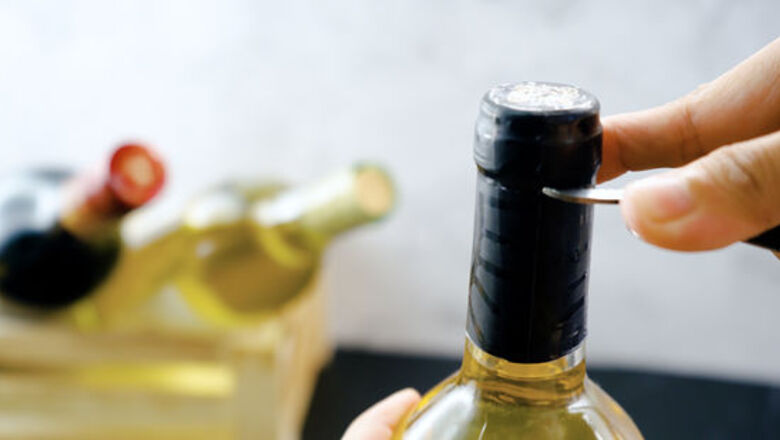
views
- Use the knife in the waiter’s corkscrew to cut the foil cap off the lip of the bottle. Screw the corkscrew clockwise into the center of the cork until 1 spiral is visible.
- Then, place the lever ridge closest to the hinge onto the edge of the bottle. Lift the handle upwards to lift the cork up, then pull the lever and handle to fully remove it.
- Or, center a wing corkscrew over the cork, twisting the handle clockwise until the wings are perpendicular to the bottle. Press down on the wings to pull the cork out.
Using a Waiter’s Corkscrew
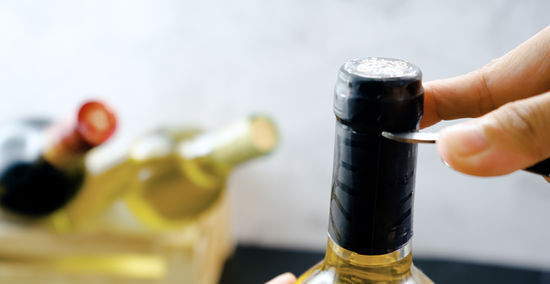
Cut the foil below the top lip of the bottle with the folded knife. The waiter’s corkscrew (also known as a wine key or a sommelier knife) is a Swiss army knife-like gadget with a folded knife on one end and a folded corkscrew on the other. Just unfold the knife and use it to score the foil just below the lip at the top of the wine bottle. Simply peel off the foil cap and discard it, then tuck the knife back into its compartment. Some waiter’s corkscrews have a sharp disc, rather than a knife, for cutting the foil. Always cut just below the lip of the wine bottle to prevent any wine from touching it when you pour it. If the wine comes into contact with the foil, it can change its taste.
Unfold the corkscrew and twist it clockwise into the middle of the cork. Open the waiter’s corkscrew all the way so the corkscrew is exposed and the handle and lever are extended horizontally on either side. Place your wine bottle on a flat, sturdy surface and position the tip of the corkscrew in the center of the cork. Push it in slightly, then begin twisting the handles clockwise. Keep twisting the corkscrew until only 1 spiral of the screw is visible. It usually takes about 6 ½ twists to screw in the corkscrew. Don't twist all the way through the cork, or pieces from the bottom of the cork may end up in the wine. If you don't twist far enough, the cork may break in 2 when you extract it. EXPERT TIP Murphy Perng Murphy Perng Certified Wine Consultant Murphy Perng is a Wine Consultant and the Founder and Host of Matter of Wine, a business that produces educational wine events, including team-building experiences, networking events, and private parties. Based in Los Angeles, California, Murphy has served as a Wine Educator for clients such as Google, Buzzfeed, Tiktok, Snapchat, and Equinox and been featured on National Geographic and The Somm Journal. Murphy possesses her WSET (Wine & Spirit Education Trust) Level 3 Advanced Certification. Murphy Perng Murphy Perng Certified Wine Consultant Expert Trick: When you're twisting a waiter’s corkscrew into the cork, be sure to twist the corkscrew, rather than turning the bottle. Otherwise, it will be harder to tell when the corkscrew reaches the bottom of the cork, and you may not have enough leverage to open the bottle.
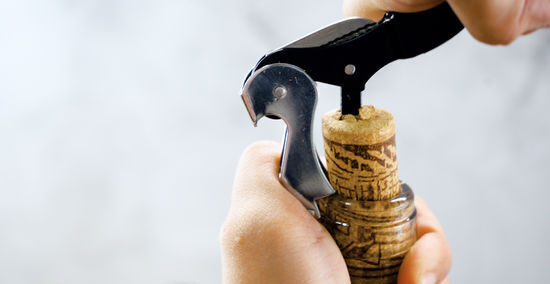
Place the lever’s ridges on the edge of the bottle to pull out the cork. Bend the lever arm down toward the neck of the bottle while keeping the handle perpendicular to the bottle. Most corkscrews have 2 indentations or ridges along the inside of the lever arm. Set the ridge closest to the lever arm's hinge over the lip of the bottle, then pull the handle upwards—this creates leverage that nudges the cork upward. If the first ridge doesn’t pull the cork out enough, set the ridge that's furthest from the lever arm's hinge on the bottle’s lip. Just repeat the process to dislodge the cork further. If the cork won't budge, you may not have twisted the corkscrew far enough. Twist it until there is only one spiral remaining before using the lever.
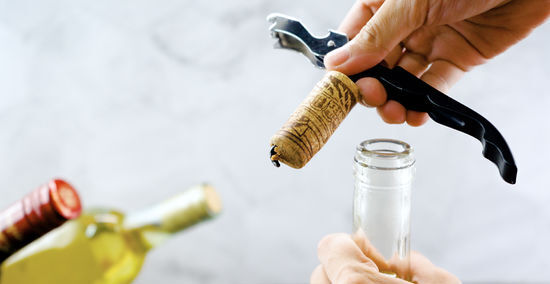
Pull up on the handle and lever to remove the cork. Lift the lever arm back up so the corkscrew is in a T-shape. Then, pull up firmly on both the handle and the lever arm. If you feel any resistance, wiggle and twist the cork a bit as you pull upward. The cork will easily lift from the bottle with a slight pop. If the cork doesn't lift out of the bottle, screw the corkscrew in deeper, lift the cork using the lever arm, and try pulling on the handle again. In fine restaurants, sommeliers often remove the corkscrew while the cork is still about halfway in the bottle, then finish removing the cork by hand. The cork is set on the table for the patron to examine for signs of freshness.
Opening with a Wing Corkscrew
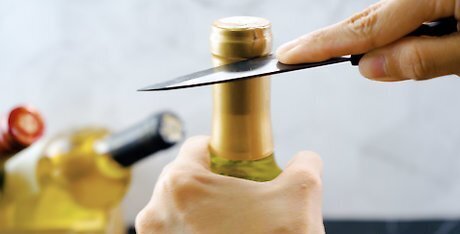
Score the cork foil under the lip with a knife and peel it away. Most wing corkscrews don't come with knife attachments. So, set the wine bottle on a flat surface and use a sharp kitchen knife to score the foil just under the lip of the wine bottle. Pull off the foil cap and discard it. If your wing corkscrew does have an integrated knife, go ahead and use it! No matter what type of knife you use, work carefully so you don’t slip and cut your hand.
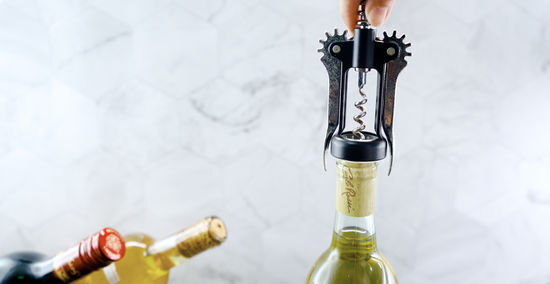
Set the corkscrew in the center of the cork. Place the tip of the corkscrew in the middle of the cork and push down gently. Rest the metal cap surrounding the screw against the top of the bottle. In this position, the wings or levers on either side of the corkscrew are lowered against the neck of the wine bottle. Simply indent the top of the cork with the tip of the screw–you don’t need to deeply embed it at this point.
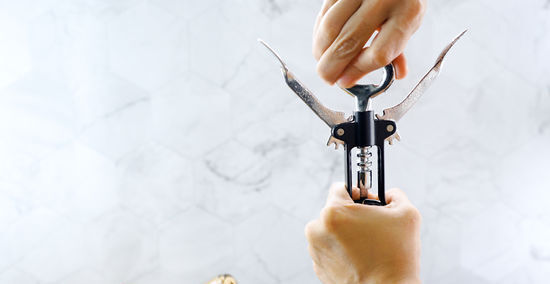
Twist the handle clockwise to drill the screw into the cork. Hold the metal cap in place over the bottle’s top, keeping your hand below the wings that are lowered against the neck of the wine bottle. Use your other hand to turn the handle and screw the corkscrew into the cork. Each time you twist, the wings extend a bit further upward and outward. Continue turning the handle until the wings are fully extended—that is, until they’re perpendicular to the wine bottle and parallel to the table. With the wings fully extended, the screw is typically at the ideal depth inside the cork. Don't continue twisting, or you might drive the screw through the bottom of the cork, which can leave cork bits in your wine!
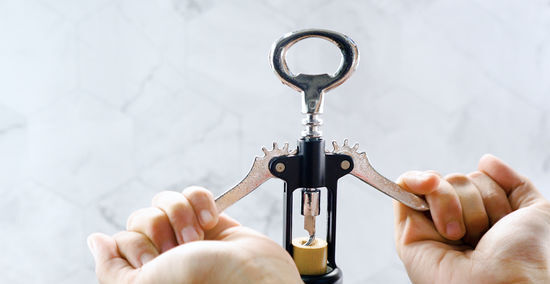
Push down on the wings to pull the cork upward. With your bottle placed firmly on a table, use both of your hands to push down the wings of the corkscrew. As you push them down, the screw retracts and lifts the cork up. Once the wings are fully down and against the neck of the bottle, the cork is fully removed. If the cork isn’t quite free of the bottle yet, give the corkscrew a few wiggles and twists, then pull upward to finish removing the cork. If it still isn’t free, twist the screw back down into the cork until the wings are halfway extended, then repeat the process.
Using an Electric Corkscrew
Twist the foil cutter around the top of the bottle to remove the cap. Most electric corkscrews come with a foil cutter attachment that often doubles as a stand. Just place your bottle of wine on a table and set the foil cutter around the top of the bottle. Squeeze the sides of the cutter with one hand as you rotate the bottle with your other. Then, peel off the cap and throw it away. If your corkscrew doesn’t have a foil cutter, simply use a knife to cut the foil below the bottom lip of the bottle.
Position the corkscrew on top of the bottle. Place the opening of the corkscrew over the top of the bottle, centering it over the cork with one hand. Then, hold the base of the bottle steady with your other hand.
Hold down on the bottom button to remove the cork. Look for the down switch or button on your corkscrew; on most types, it’s the button closest to the bottom of the corkscrew. Then, press and hold the down button to twist the corkscrew into the cork. Just keep holding the button until the corkscrew screws the cork out of the bottle. You’ll usually hear a higher-pitched sound when the corkscrew starts twisting the cork out of the bottle. When you no longer hear a screwing noise, the cork is fully removed. Some electric corkscrews have a see-through tip, so you’re able to watch when the corkscrew pulls out the cork.
Press and hold the top button to remove the cork from the corkscrew. To get the cork out of your corkscrew, simply hold down on the button or switch above the down button. Just place your hand over the bottom of the corkscrew to catch the cork as it falls out.
Uncorking with a Screw and Pliers
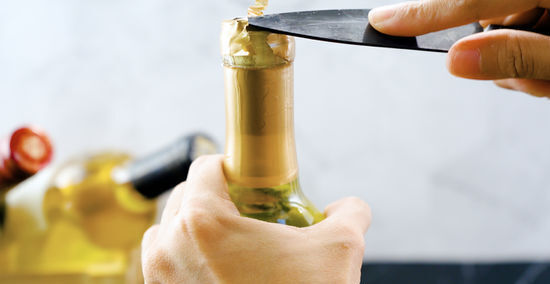
Cut off the foil that covers the cork with a knife. Set your bottle of wine on a table or counter and use a kitchen knife to score the foil just below the lip of the wine bottle. Then, take off the foil cap and discard it. Work very carefully with the knife. Nothing ruins a nice evening and a great bottle of wine like a deep gash in your hand! If you don’t have a screw and pliers, there are other easy ways to open wine without a corkscrew. Just carefully twist a kitchen knife, a pair of scissors, paper clips, or a wire hanger into the cork. Or, if all else fails, push the cork into the bottle.
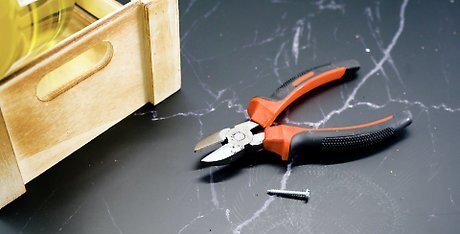
Grab a clean 2 in (5.1 cm) screw and a set of pliers. The average wine cork is about 1.75 in (4.4 cm) in length, so you need a screw that’s long enough to drive deeply into the cork and that protrudes out of the top of it by about 0.5 in (1.3 cm). Even though the screw won’t touch the wine, wash it off with soap and water. Disinfect the screw by soaking it in a dish of rubbing alcohol for 1-2 minutes. Even better, sterilize it by placing it in boiling water for 5 to 15 minutes, then let the water cool. A slightly shorter screw may work, but don’t go any shorter than 1.5 in (3.8 cm) in length.
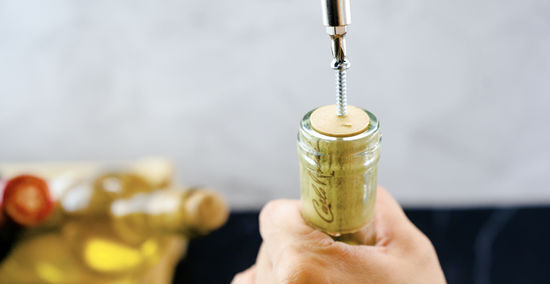
Twist the screw clockwise into the middle of the cork with a screwdriver. Press the tip of the screw into the center of the cork to make a starting indentation. Then, turn the screw into the center of the cork until there is about 0.5 in (1.3 cm) sticking out. Either twist the screw in with your fingers, or use a screwdriver to make the job easier. Remember to twist the screw clockwise to drive it into a cork (just like how you twist a screw into wood or anything else). Work carefully to ensure that the cork does not break apart into smaller pieces. Do not twist the screw so far that it pierces the bottom of the cork or touches the wine. If you’re using a screw that’s 2.25 or 2.5 in (5.7 or 6.4 cm) long, leave 1 in (2.5 cm) protruding from the top of the cork.
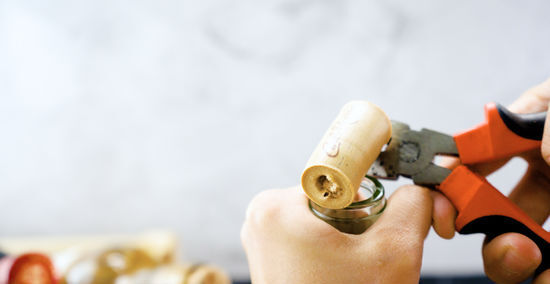
Grip the neck of the screw with the pliers and pull upward. Clasp the jaws of the pliers firmly around the neck of the screw, just below the screw head. Grab the bottle securely with your other hand, and pull upward with the pliers. Wiggle the pliers back and forth a bit if the cork is giving some resistance. If you don’t have pliers, use the claw (nail-pulling side) of a hammer, or even a sturdy fork, to pull on the screw. If the screw pulls out of the cork and leaves it in the bottle, you probably didn’t drive the screw deep enough into the cork. Repeat the process, twisting the screw as far into the cork as possible without piercing the bottom of the cork.

Use a clean screw-in hook as an alternative to a traditional screw. Any screw-in hook with a screw portion that’s at least 1.5 in (3.8 cm) long works well. Just twist it in clockwise by hand, so that the screw portion penetrates about 1.5 in (3.8 cm) deep into the cork. Then, pull on the hook portion to remove the cork. Before using it, clean the screw-in hook in the same manner as described for a regular screw. If you want extra leverage, loop the handle of a kitchen utensil, like a wooden spoon or spatula, through the hook. Then, pull up on the handle to remove the cork. Bicycle hooks, which you use to hang a bike from a wall or ceiling, work well for this. The hook portion is usually vinyl coated, which makes them more comfortable to grip and pull on.
Banging the Bottle with a Shoe
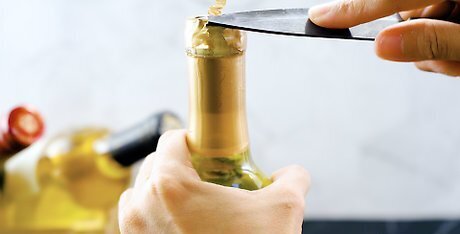
Cut the cork foil below the lip of the bottle with a knife and peel it away. Place your wine bottle on a flat surface and use a kitchen knife to score the foil just below the lip of the wine bottle. Then, remove the foil cap and throw it away. Hold the bottle securely with your free hand, but keep it well clear of the knife tip and blade.

Place the wine bottle upside down between your thighs. Sit down on a steady chair and hold the wine bottle securely between your legs. Position the bottle so the top is pointing downwards and the base of the bottle is pointing upwards towards you. Grasp the bottle near its bottom (which is now facing upward) with one hand to hold it steady.
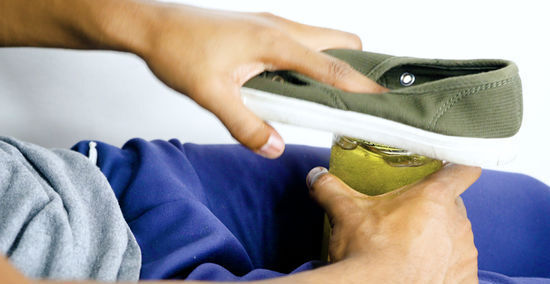
Rap the bottle firmly but carefully with the sole of a shoe. Hold the bottle steady with your legs and one hand. Then, use your other hand to strike the bottle firmly and evenly across the base 2 to 3 times with the sole of a flat shoe. With each hit, the cork dislodges a little. Don't hit the bottle as hard as you can and don't graze the edge, as the bottle may break. If you aren’t making a lot of progress, carefully hit it harder. As an alternative, place the bottom of the bottle inside a shoe with a hard sole, so the top of the bottle sticks out of the opening. Then, gently but firmly bang the sole of the shoe against a hard wall.
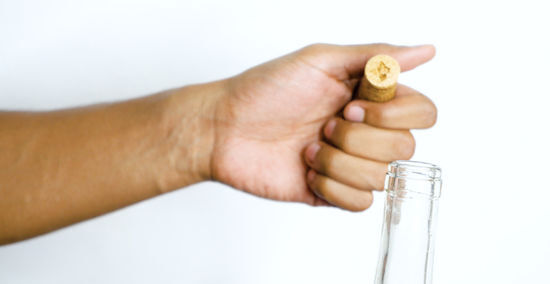
Pull the cork out by hand when you can firmly grasp it. Take a look at the cork's progress after each smack. Continue striking the bottle until there’s enough cork out of the bottle that you’re able to grab. Just grasp the cork with your hand and pull it out of the bottle. If you pull on the cork and it's still firmly inside the bottle, turn it upside down and strike it a few more times before trying again. Don't keep striking the bottle until the cork pops out on its own, or you may lose a few glasses of wine!
Removing a Screw-Top Cap
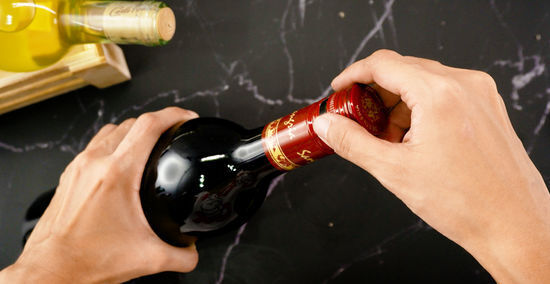
Twist the bottom of the bottle and the cap in opposite directions. Grasp the bottom of the bottle firmly in one hand, with your palm flat against the bottom. Grip your other hand around the neck and cap. Wrap your index finger and thumb tightly around the cap and loosely wrap the rest of your hand around the neck. Rotate your hands in opposite directions until you hear the “crack” that indicates that the seal is broken. Some people prefer to grab the bottom of the bottle by wrapping their palm and fingers around the base. Use whichever grip is easier for you. Wrapping your entire hand around just the bottle cap may make it more difficult to get a good grip, especially if you have arthritis or a similar condition.
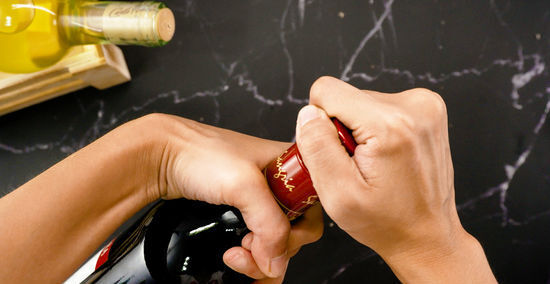
Twist the bottle’s sleeve (or skirt) instead of the cap if it will rotate. Screw-top wine bottles have a sleeve (or skirt) on the neck of the bottle that connects to the sealed cap. In some cases, this sleeve rotates independently of the bottle. Grip just the sleeve (not the cap) in one hand, and the bottom of the bottle in the other. Then, rotate your hands in opposite directions. When you hear a “crack,” the seal is broken. Many people find gripping the sleeve instead of the cap easier. However, not all sleeves rotate independently of the bottle. In this case, you’ll have to grip the cap instead.
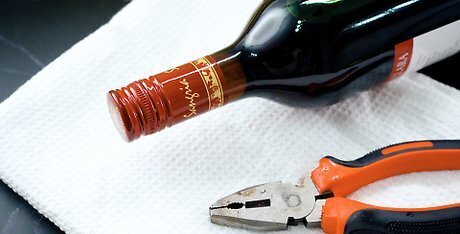
Use a dish towel, pliers, or bottle-opener gadgets to get a good grip. If you can’t grasp the cap well, place a dish towel between your hand and the cap. If that doesn’t work, grip the cap firmly (but not too forcefully) between the jaws of a set of pliers, then twist the cap and the bottle in opposite directions. Look in stores and online for bottle opener gadgets like textured silicone mats and jar opener belts that wrap around the cap or lid. Try out different gadgets until you find the type that works best for you. If you squeeze too hard with the pliers, you might crush the cap and the top of the bottle. This will make a mess, ruin the wine, and possibly cause injuries from broken glass.
















Comments
0 comment